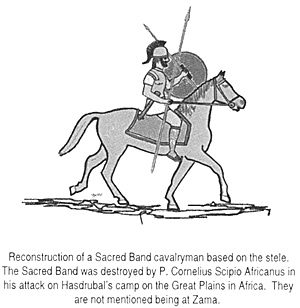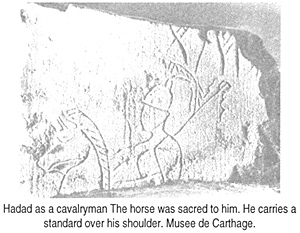 The early Carthaginian armies resembled those employed by the great Asian cities, and later by the Persian kings. They were formed of bands of men recruited from a wide variety of nations, who all maintained their native arms and tactics. Commanding such a force was difficult, since co-ordinating it with the many languages was rather hard, and logistics were next to impossible to carry out. This caused the army to have a string of defeats. Like the Persians the Carthaginians eventually saw the success of Hellenic hoplite system and wanted to copy it. The problem was there was no true yeoman farmers in the mercantile nation that could used for material. This meant the nobility itself had to form the phalanx which was called the Sacred Band. The generals also started a program of training light armed Libyans as hoplites. The other means was using Greeks when they could hire them, although they felt Greeks couldn't be trusted.
The early Carthaginian armies resembled those employed by the great Asian cities, and later by the Persian kings. They were formed of bands of men recruited from a wide variety of nations, who all maintained their native arms and tactics. Commanding such a force was difficult, since co-ordinating it with the many languages was rather hard, and logistics were next to impossible to carry out. This caused the army to have a string of defeats. Like the Persians the Carthaginians eventually saw the success of Hellenic hoplite system and wanted to copy it. The problem was there was no true yeoman farmers in the mercantile nation that could used for material. This meant the nobility itself had to form the phalanx which was called the Sacred Band. The generals also started a program of training light armed Libyans as hoplites. The other means was using Greeks when they could hire them, although they felt Greeks couldn't be trusted.
By the time they fought Pyrrhus, they were turning towards the Hellenistic system. The Sacred Band to imitate the Aegema remounted, and the Libyan phalanx was starting to use half breeds called Liby-Phoenicians or what the Latins called Peoni. This gave a more dependable infantry, something many authors seem to have overlooked. Carthage also became interested in the elephant, having to deal with those of those of Pyrrhus, and were trapping the small bush elephant from the nearby jungles
The M. Atilius Regulus invasion in 256 brought matters to a head. When the Carthaginians were defeated in the first battle they asked for terms. Atilius, which history has portrayed as the arrogant aristocratic Roman, set the terms so high that Carthage was forced to continue the war.
However the Senate, convinced that peace was imminent, and to save money, had already withdrawn half the army. This gave the Carthaginians a chance. They recruited a new army and started to train it. Enter Xanthippios. This was a Spartan mercenary who sounds like he was hired like a drill sergeant to teach the army how to drill and maneuver in phalanx. He saw that the army had good material especially in cavalry, and offered to command them.
Since he technically couldn't command the army he was made military advisor to Hasdrubal. Remember him? Yes the guy who was later executed for failing to take Panormus. But that was in the future. With 12,000 foot, in at least two phalanxes of 4000, one being composed of mercenaries, plus 4000 light infantry, 4000 horse, the army was ready to advance to Tunis. Xanthippios' ace in the hole was enough elephants to cover his infantry front, consisting of at least seventy-five.
Atilius accepted battle. He had four legiones minus losses (15,000), two being veteran Romans. As Caven says "He saw no reason that a once beaten collection of shopkeepers and mercenaries would not be beaten again." [Caven, The Punic Wars. 38]
This time, though, the Carthaginians had more cavalry, and in anticipation Atilius deepened his formation so they couldn't break through. (Either going from five ranks to ten or from ten to twenty. Probably the latter) He halved his front. Which of course played right into Xanthippios' hands. The horse was not going to charge the deep maniples, the elephants were. The cavalry was going to eliminate the 500 Roman and allied horse. (This to me was the real reason Regulus lost. Where were the rest of the horse? The Consul should have had 600 Equites, and 12-1400 Socii horse. There is no mention of horse losses in the campaign so far but there must have been.)
The plan went off without a hitch. The elephants disrupted the maniples, the Roman and allied horse was swept from the field. Then showing discipline, the Punics returned to pin the Legiones from the flank. Without the ability to exchange lines, the legiones were trapped, compressed, destroyed. (Where have we heard this before?)
This victory completed the Carthaginian reorganization. They now depended on the Greek phalanx as the main battle line equipped in the Greek style with helmet, spolis or metal corslet, and round shield. (Never a Macedonian with pike as Connolly suggests but they may have formed 16 deep if needed.)
The Carthaginian horse composed a small part of the army. The heavy cavalry, as befitting a Hellenistic based army, was chiefly composed of Carthaginian nobles. An example of one might be the Punic war god Hadad, who is generally represented mounted; often the horse alone could be his emblem. We have several examples. Once away from Carthage allies had to supply this arm, usually being Spanish or Gallic nobles.
Carthage also used Numidian (Punic for nomad) horsemen for their skirmishing horse. The Numidians are seen on the Trajanic column fighting for Rome hundreds of years later. They still have braided hair and a small shield, and their only weapon is a javelin which they were accurate. They still show skill in riding their petite horses saddle-less and with only a bridle. The Balearic slingers were considered the best in the world, and Carthage was the only State to have access to them.
Once away from Carthage, the army composition changed. The only Africans in the army were Liby-Phoenicians and Numidians. The light infantry arm was made up of subjects and allies. Nevertheless this is a true Hellenistic organized army. The phalanx is the anvil, the horse the hammer, the elephants the pin. The lights would overwhelm the enemy lights with their greater numbers and open the way for the elephants.
The Carthaginian battle manual must have been written by Xanthippios. It could be composed of one sentence. "Find flat ground, use your skirmisher advantage to drive off his horse with your better horse, return and take the enemy in the flanks and rear, slaughter them with the heavy foot." It was to be the standard Carthaginian tactic until Hannibal changed it.
 Hannibal's Adaptions
Hannibal's Adaptions
Hannibal's adaptions were common sense. He could not waste his African spear men, (he had no control of the sea to get reenforcements) so he changed the anvil to Spanish heavy infantry using his barbarian warbands as the pin replacing the elephants, while retaining his horse as the hammer. He still won a lot of battles doing it in this way.
He second innovation was using light infantry in ambushes. He likely learned about these from his Spanish allies, who did it to each other all the time.
Hannibal appreciated the Roman manipular system. However he thought the line exchange was the weakest part of the process. Still, he was willing to incorporate some ideas from it. He agreed that Celtic mail shirts were better then thickened linen. He liked the idea of a double line for inferior infantry in front, superior infantry behind, if the space was available. The enemy would waste his strength on the inferior foot, before having to deal with the second line. He also admired the Roman siege and camp craft. His forces could never compete with Romans in building camps or siege machines.
Hannibal had beaten the Roman armies in most of his Italian battles. His few recorded loses were apparently Roman propaganda and could be better termed "draws" The Romans never expelled him by force from Italy. He only left after being summoned by his government to return and preserve Carthage. For this reason alone he must be ranked as one if not the greatest captain of all time.
Survey of the Carthaginian Army: The Time of Hannibal
Back to Strategikon Vol. 2 No. 1 Table of Contents
Back to Strategikon List of Issues
Back to MagWeb Master Magazine List
© Copyright 2002 by NMPI
This article appears in MagWeb (Magazine Web) on the Internet World Wide Web. Other military history articles and gaming articles are available at http://www.magweb.com